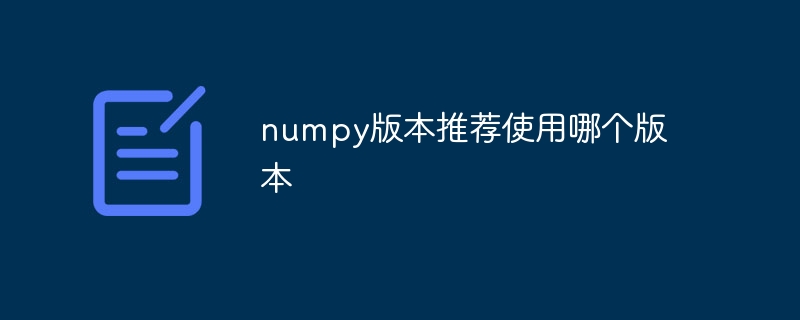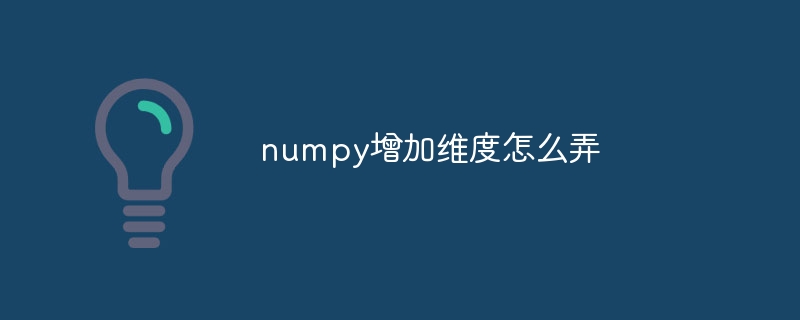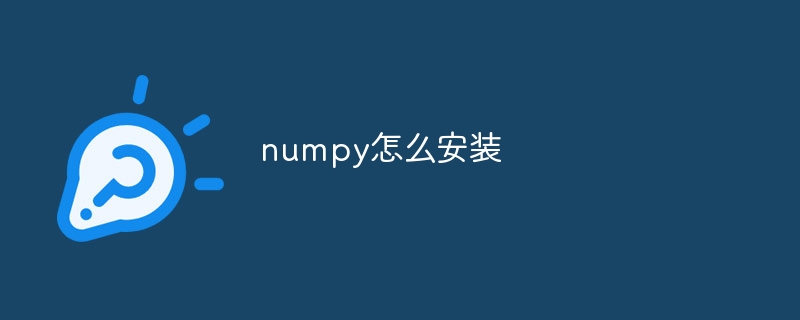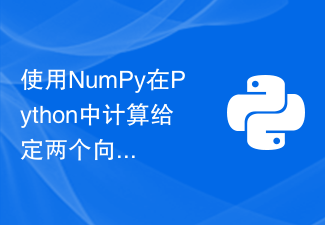This article mainly introduces the addition, deletion, modification and query of Numpy array data. It has certain reference value. Now I share it with you. Friends in need can refer to it
Preparation work:
There are many ways to add, delete, modify, and check. Here are only some commonly used ones.
>>> import numpy as np >>> a = np.array([[1,2],[3,4],[5,6]])#创建3行2列二维数组。 >>> a array([[1, 2], [3, 4], [5, 6]]) >>> a = np.zeros(6)#创建长度为6的,元素都是0一维数组 >>> a = np.zeros((2,3))#创建3行2列,元素都是0的二维数组 >>> a = np.ones((2,3))#创建3行2列,元素都是1的二维数组 >>> a = np.empty((2,3)) #创建3行2列,未初始化的二维数组 >>> a = np.arange(6)#创建长度为6的,元素都是0一维数组array([0, 1, 2, 3, 4, 5]) >>> a = np.arange(1,7,1)#结果与np.arange(6)一样。第一,二个参数意思是数值从1〜6,不包括7.第三个参数表步长为1. a = np.linspace(0,10,7) # 生成首位是0,末位是10,含7个数的等差数列[ 0. 1.66666667 3.33333333 5. 6.66666667 8.33333333 10. ] a = np.logspace(0,4,5)#用于生成首位是10**0,末位是10**4,含5个数的等比数列。[ 1.00000000e+00 1.00000000e+01 1.00000000e+02 1.00000000e+03 1.00000000e+04]
increased
>>> a = np.array([[1,2],[3,4],[5,6]]) >>> b = np.array([[10,20],[30,40],[50,60]]) >>> np.vstack((a,b)) array([[ 1, 2], [ 3, 4], [ 5, 6], [10, 20], [30, 40], [50, 60]]) >>> np.hstack((a,b)) array([[ 1, 2, 10, 20], [ 3, 4, 30, 40], [ 5, 6, 50, 60]])
Direct addition of arrays of different dimensions is obviously not allowed. But you can use an n column vector and an m column row vector to construct an n×m matrix
>>> a = np.array([[1],[2]]) >>> a array([[1], [2]]) >>> b=([[10,20,30]])#生成一个list,注意,不是np.array。 >>> b [[10, 20, 30]] >>> a+b array([[11, 21, 31], [12, 22, 32]]) >>> c = np.array([10,20,30]) >>> c array([10, 20, 30]) >>> c.shape (3,) >>> a+c array([[11, 21, 31], [12, 22, 32]])
check
>>> a array([[1, 2], [3, 4], [5, 6]]) >>> a[0] # array([1, 2]) >>> a[0][1]#2 >>> a[0,1]#2 >>> b = np.arange(6)#array([0, 1, 2, 3, 4, 5]) >>> b[1:3]#右边开区间array([1, 2]) >>> b[:3]#左边默认为 0array([0, 1, 2]) >>> b[3:]#右边默认为元素个数array([3, 4, 5]) >>> b[0:4:2]#下标递增2array([0, 2])
NumPy’s where function uses
np.where(condition, x, y), No. One parameter is a boolean array, and the second and third parameters can be scalars or arrays.
cond = numpy.array([True,False,True,False]) a = numpy.where(cond,-2,2)# [-2 2 -2 2] cond = numpy.array([1,2,3,4]) a = numpy.where(cond>2,-2,2)# [ 2 2 -2 -2] b1 = numpy.array([-1,-2,-3,-4]) b2 = numpy.array([1,2,3,4]) a = numpy.where(cond>2,b1,b2) # 长度须匹配# [1,2,-3,-4]
Change
>>> a = np.array([[1,2],[3,4],[5,6]]) >>> a[0] = [11,22]#修改第一行数组[1,2]为[11,22]。 >>> a[0][0] = 111#修改第一个元素为111,修改后,第一个元素“1”改为“111”。 >>> a = np.array([[1,2],[3,4],[5,6]]) >>> b = np.array([[10,20],[30,40],[50,60]]) >>> a+b #加法必须在两个相同大小的数组键间运算。 array([[11, 22], [33, 44], [55, 66]])
Direct addition of arrays of different dimensions is obviously not allowed. But you can use an n column vector and an m column row vector to construct an n×m matrix
>>> a = np.array([[1],[2]]) >>> a array([[1], [2]]) >>> b=([[10,20,30]])#生成一个list,注意,不是np.array。 >>> b [[10, 20, 30]] >>> a+b array([[11, 21, 31], [12, 22, 32]]) >>> c = np.array([10,20,30]) >>> c array([10, 20, 30]) >>> c.shape (3,) >>> a+c array([[11, 21, 31], [12, 22, 32]])
array and the operations of addition, subtraction, multiplication and division of a number, It is equivalent to a broadcast, broadcasting this operation to each element.
>>> a = np.array([[1,2],[3,4],[5,6]]) >>> a*2#相当于a中各个元素都乘以2.类似于广播。 array([[ 2, 4], [ 6, 8], [10, 12]]) >>> a**2 array([[ 1, 4], [ 9, 16], [25, 36]]) >>> a>3 array([[False, False], [False, True], [ True, True]]) >>> a+3 array([[4, 5], [6, 7], [8, 9]]) >>> a/2 array([[0.5, 1. ], [1.5, 2. ], [2.5, 3. ]])
Delete
Method 1:
Use the method in the search, such as a=a[0]. After the operation, there is only one row left for a.
>>> a = np.array([[1,2],[3,4],[5,6]]) >>> a[0] array([1, 2])
Method 2:
>>> a = np.array([[1,2],[3,4],[5,6]]) >>> np.delete(a,1,axis = 0)#删除a的第二行。 array([[1, 2], [5, 6]]) >>> np.delete(a,(1,2),0)#删除a的第二,三行。 array([[1, 2]]) >>> np.delete(a,1,axis = 1)#删除a的第二列。 array([[1], [3], [5]])
Method 3:
First split, and then assign value according to slice a=a[0].
>>> a = np.array([[1,2],[3,4],[5,6]]) >>> np.hsplit(a,2)#水平分割(搞不懂,明明是垂直分割嘛?) [array([[1], [3], [5]]), array([[2], [4], [6]])] >>> np.split(a,2,axis = 1)#与np.hsplit(a,2)效果一样。 >>> np.vsplit(a,3) [array([[1, 2]]), array([[3, 4]]), array([[5, 6]])] >>> np.split(a,3,axis = 0)#与np.vsplit(a,3)效果一样。
Related recommendations:
Methods for storing and reading data in text format in numpy
The above is the detailed content of Add, delete, modify, and query Numpy array data. For more information, please follow other related articles on the PHP Chinese website!
 怎么更新numpy版本Nov 28, 2023 pm 05:50 PM
怎么更新numpy版本Nov 28, 2023 pm 05:50 PM更新numpy版本方法:1、使用“pip install --upgrade numpy”命令;2、使用的是Python 3.x版本,使用“pip3 install --upgrade numpy”命令,将会下载并安装,覆盖当前的NumPy版本;3、若使用的是conda来管理Python环境,使用“conda install --update numpy”命令更新即可。
 numpy版本推荐使用哪个版本Nov 22, 2023 pm 04:58 PM
numpy版本推荐使用哪个版本Nov 22, 2023 pm 04:58 PM推荐使用最新版本的NumPy1.21.2。原因是:目前,NumPy的最新稳定版本是1.21.2。通常情况下,推荐使用最新版本的NumPy,因为它包含了最新的功能和性能优化,并且修复了之前版本中的一些问题和错误。
 python numpy中linspace函数怎么使用May 01, 2023 am 09:34 AM
python numpy中linspace函数怎么使用May 01, 2023 am 09:34 AMpythonnumpy中linspace函数numpy提供linspace函数(有时也称为np.linspace)是python中创建数值序列工具。与Numpyarange函数类似,生成结构与Numpy数组类似的均匀分布的数值序列。两者虽有些差异,但大多数人更愿意使用linspace函数,其很好理解,但我们需要去学习如何使用。本文我们学习linspace函数及其他语法,并通过示例解释具体参数。最后也顺便提及np.linspace和np.arange之间的差异。1.快速了解通过定义均匀间隔创建数值
 如何查看numpy版本Nov 21, 2023 pm 04:12 PM
如何查看numpy版本Nov 21, 2023 pm 04:12 PM查看numpy版本的方法:1、使用命令行查看版本,这将打印出当前版本;2、使用Python脚本查看版本,将在控制台输出当前版本;3、使用Jupyter Notebook查看版本,将在输出单元格中显示当前版本;4、使用Anaconda Navigator查看版本,在已安装的软件包列表中,可以找到其版本;5、在Python交互式环境中查看版本,将直接输出当前安装的版本。
 numpy增加维度怎么弄Nov 22, 2023 am 11:48 AM
numpy增加维度怎么弄Nov 22, 2023 am 11:48 AMnumpy增加维度的方法:1、使用“np.newaxis”增加维度,“np.newaxis”是一个特殊的索引值,用于在指定位置插入一个新的维度,可以通过在对应的位置使用np.newaxis来增加维度;2、使用“np.expand_dims()”增加维度,“np.expand_dims()”函数可以在指定的位置插入一个新的维度,用于增加数组的维度
 如何使用Python中的numpy计算矩阵或ndArray的行列式?Aug 18, 2023 pm 11:57 PM
如何使用Python中的numpy计算矩阵或ndArray的行列式?Aug 18, 2023 pm 11:57 PM在本文中,我们将学习如何使用Python中的numpy库计算矩阵的行列式。矩阵的行列式是一个可以以紧凑形式表示矩阵的标量值。它是线性代数中一个有用的量,并且在物理学、工程学和计算机科学等各个领域都有多种应用。在本文中,我们首先将讨论行列式的定义和性质。然后我们将学习如何使用numpy计算矩阵的行列式,并通过一些实例来看它在实践中的应用。行列式的定义和性质Thedeterminantofamatrixisascalarvaluethatcanbeusedtodescribethepropertie
 numpy怎么安装Dec 01, 2023 pm 02:16 PM
numpy怎么安装Dec 01, 2023 pm 02:16 PMnumpy可以通过使用pip、conda、源码和Anaconda来安装。详细介绍:1、pip,在命令行中输入pip install numpy即可;2、conda,在命令行中输入conda install numpy即可;3、源码,解压源码包或进入源码目录,在命令行中输入python setup.py build python setup.py install即可。
 使用NumPy在Python中计算给定两个向量的外积Sep 01, 2023 pm 03:41 PM
使用NumPy在Python中计算给定两个向量的外积Sep 01, 2023 pm 03:41 PM两个向量的外积是向量A的每个元素与向量B的每个元素相乘得到的矩阵。向量a和b的外积为a⊗b。以下是计算外积的数学公式。a⊗b=[a[0]*b,a[1]*b,...,a[m-1]*b]哪里,a,b是向量。表示两个向量的逐元素乘法。外积的输出是一个矩阵,其中i和j是矩阵的元素,其中第i行是通过将向量‘a’的第i个元素乘以向量‘b’的第i个元素得到的向量。使用Numpy计算外积在Numpy中,我们有一个名为outer()的函数,用于计算两个向量的外积。语法下面是outer()函数的语法-np.oute


Hot AI Tools

Undresser.AI Undress
AI-powered app for creating realistic nude photos

AI Clothes Remover
Online AI tool for removing clothes from photos.

Undress AI Tool
Undress images for free

Clothoff.io
AI clothes remover

AI Hentai Generator
Generate AI Hentai for free.

Hot Article

Hot Tools

DVWA
Damn Vulnerable Web App (DVWA) is a PHP/MySQL web application that is very vulnerable. Its main goals are to be an aid for security professionals to test their skills and tools in a legal environment, to help web developers better understand the process of securing web applications, and to help teachers/students teach/learn in a classroom environment Web application security. The goal of DVWA is to practice some of the most common web vulnerabilities through a simple and straightforward interface, with varying degrees of difficulty. Please note that this software

Atom editor mac version download
The most popular open source editor

SecLists
SecLists is the ultimate security tester's companion. It is a collection of various types of lists that are frequently used during security assessments, all in one place. SecLists helps make security testing more efficient and productive by conveniently providing all the lists a security tester might need. List types include usernames, passwords, URLs, fuzzing payloads, sensitive data patterns, web shells, and more. The tester can simply pull this repository onto a new test machine and he will have access to every type of list he needs.

Dreamweaver Mac version
Visual web development tools

Zend Studio 13.0.1
Powerful PHP integrated development environment






